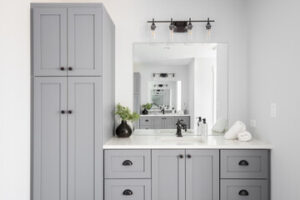Everyone enjoys a warm shower or bubbling bath, and that convenience wouldn’t be possible without plumbers. These skilled professionals install and repair pipes that carry water, waste, and gas throughout homes and buildings. They also inspect plumbing systems, interpreting blueprints and building codes to ensure the pipes are properly installed. Contact Plumbers Linden NJ now!
Plumbers install and repair pipes, fixtures, appliances, and other components related to water and sewage systems in homes and businesses. Their work is important for ensuring that people have safe, reliable access to water and that waste is properly disposed of. Plumbers also help protect against the spread of disease by ensuring that water supply and drainage systems are free from dangerous bacteria and microbes.

Plumbing professionals are typically required to complete an apprenticeship program or a tradesman certificate course to gain the necessary skills and knowledge for the job. Plumbers must be able to read and interpret blueprints and architectural drawings in order to plan plumbing installations. They may also be responsible for ensuring that their work meets local building codes and regulations.
The most common type of plumbing work performed by plumbers is on residential properties. This can include installing new fixtures and appliances such as sinks, toilets, showers, and water heaters, as well as repairing or replacing existing ones. Plumbers may also be asked to inspect a home’s plumbing system and make recommendations on how to improve it.
When working on residential plumbing, plumbers must be aware of the potential health risks associated with old or damaged pipes. Lead pipes, for example, are known to cause health problems including lead poisoning. These pipes are typically replaced with safer alternatives such as copper or PVC. Plumbers must also be careful when working on sewage systems, as they may be exposed to dangerous microbes and bacteria that are excreted in human waste.
Commercial and industrial plumbers work on larger-scale plumbing systems found in office buildings, retail stores, restaurants, and other large structures. These plumbers often have to install and maintain complicated water filtration and cooling systems. They may also be required to work with features like fire sprinklers, which require specialized knowledge and equipment.
Maintenance
Plumbers install plumbing fixtures like bathtubs, showers, sinks, and toilets. They also repair and maintain existing plumbing systems. This can include removing and replacing old parts, fixing leaks, or installing new pipes. They may work on residential or commercial properties.
When it comes to plumbing maintenance, plumbers need to have good customer service skills to interact with their clients. This includes explaining technical issues in easy-to-understand terms and providing accurate estimates for work. It also means keeping up to date on plumbing codes and regulations in their area.
Most plumbers are hired by a plumbing company, but some are self-employed contractors. These individuals often work on-call to fix emergency problems, such as clogged drains or water heater malfunctions. In these cases, plumbers need to have strong problem-solving skills and be able to think on their feet to find solutions quickly.
Another important skill for plumbers is interpreting blueprints and plans for new construction projects. They also need to understand how different types of pipes connect to each other and what kind of materials are best for each situation. This involves using specialized tools to inspect pipe joints and fixtures, such as video cameras and pressure gauges.
Plumbing is a physically demanding job that requires a lot of standing and working in tight spaces. It also involves heavy lifting and working with tools that can be dangerous if not used properly. Plumbers must have excellent physical stamina and strength, as well as manual dexterity to maneuver small parts and tools.
Plumbers often work with electricity and other hazardous materials, so they must be aware of the risks involved and take proper safety precautions. This includes wearing protective gear, following all applicable safety protocols, and taking regular breaks to rest their bodies.
Most plumbers start their careers by completing an apprenticeship program. This typically lasts four to five years and combines classroom instruction with on-the-job training. After completing the program, they must pass an exam to become licensed plumbers. The path to becoming a plumber is long and winding, but it’s one of the most rewarding trades for those who are interested in working with their hands and solving problems.
Troubleshooting
The plumbing industry offers a wide range of troubleshooting services for both commercial and residential customers. Plumbers are experts when it comes to identifying the source of problems and fixing them quickly and efficiently. They can also provide routine maintenance to keep your pipes and appliances in good working condition.
The most common problem that plumbers fix is clogged drains. They can use a variety of tools to clear out even the most stubborn clogs. They can also repair or replace damaged parts, such as drain valves and faucets. The drain system is one of the most important components of a home. When it stops working, it can cause serious issues that affect the whole house.
In addition to repairing broken or leaking pipes, plumbers can also inspect a home’s sewer lines and drainage systems to spot potential problems before they become severe. This service is often necessary for older homes that have not had their plumbing updated in a long time. A plumber can also install new fixtures, such as showerheads, toilets, and sinks.
When diagnosing a plumbing problem, it is important to have a clear definition of what the issue is. This will help you to narrow down the possible causes and determine whether the problem is caused by equipment failure, an unexpected operation, user error, or a random anomaly. It is also important to try out a solution on yourself before applying it to a customer. This will ensure that the solution works as intended and does not create any unintended side effects. A handy tool that many plumbers use is a maintenance checklist. It allows them to easily and quickly record the steps needed to solve a particular problem. It can also help them improve their process by making it more systematic and consistent.
Licensing
Plumbing fixtures have a limited lifespan and will eventually need to be replaced. Plumbers can install, repair, and replace a variety of fixtures, including toilets, showers, tubs, sinks, faucets, water heaters, laundry machines, backflow preventers, and septic tank systems. They can also inspect and test a property’s plumbing system to ensure that it is safe and functioning properly.
Licensed plumbers are required to follow strict safety standards when performing work on plumbing systems. This includes wearing appropriate personal protective equipment, following instructions from the manufacturer of any materials they use, testing components before and after installation to ensure quality, and more. This ensures the health and wellbeing of anyone in a home or business where plumbing work is being performed.
Plumbers are also required to have proper insurance coverage to protect themselves and their customers from liability in the event of an accident. This is especially important because plumbing work can be very dangerous, and even seemingly simple tasks such as sizing pipes correctly could lead to costly problems down the road if done incorrectly.
To become a licensed plumber, an individual must complete a trade school program or apprenticeship and have a minimum amount of work experience. The exact requirements vary by location, but most states require that an apprentice have a minimum number of hours working as an assistant under a journeyman or master plumber before they can take the licensing exam.
Once a person has their license, they must continue to meet their state’s requirements for continuing education and ongoing training. This helps them stay up-to-date on new technologies and best practices in the plumbing industry. It is also important for plumbers to maintain a good reputation in their community, so they can attract more clients and keep existing ones happy.
Having a high-quality, reliable plumber is essential in any household or business. Not only do they have the skills and knowledge to fix a variety of issues, but they can also save you time and money in the long run by being able to diagnose and fix the problem quickly and efficiently. The best way to find a great plumber is to search for a local licensed professional, like those at SameDayPros.

